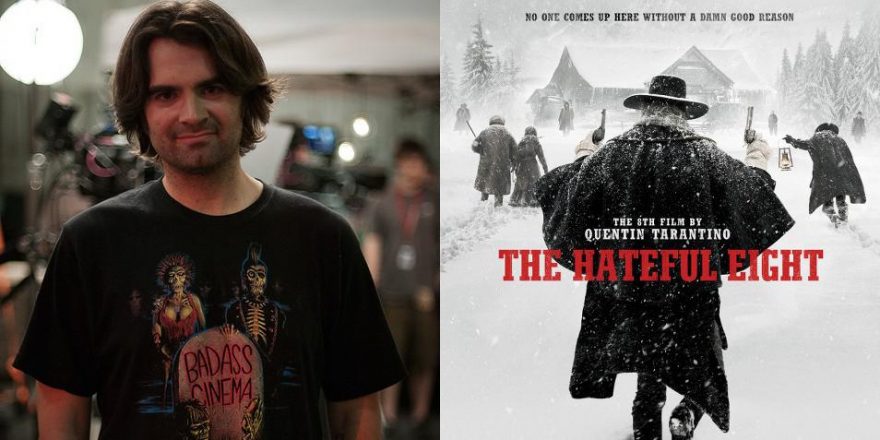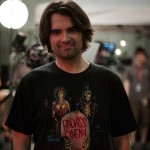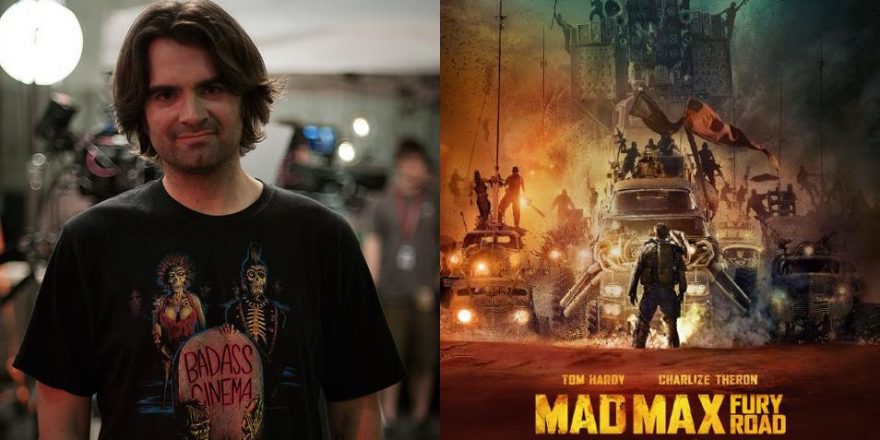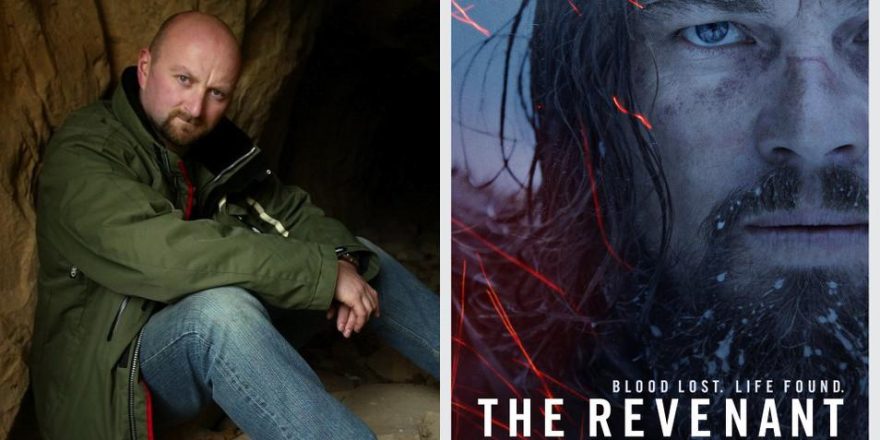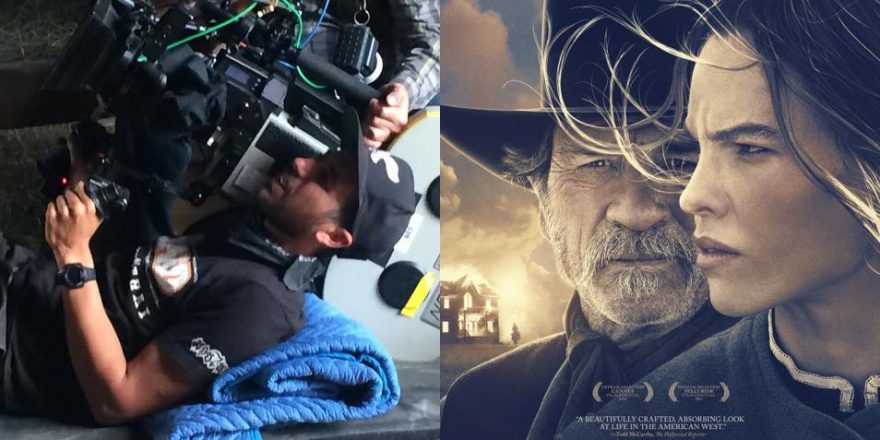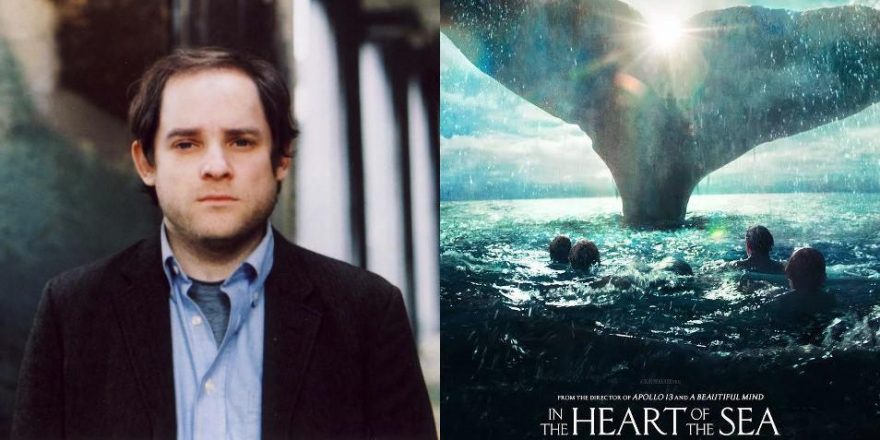OVERTURE:
“Come gather round and listen lads, and hear me tell m’ tale”
– “Jim Jones at Botany Bay,” Australian folk ballad
Chapter One:
A Visual Monologue
There is a moment in Quentin Tarantino’s The Hateful Eight, between chapter breaks in this sprawling yet intimate Western-thriller about strangers trapped together during a blizzard where all is not what it seems, when the director himself chimes in as our temporary narrator, as if from behind the camera (or from the projection booth). It’s a confidence in his own career and a knowledge of his place in pop culture that allows Tarantino – calm and collected, recounting details from a previous scene – to pull off such a broad, bold stroke by talking directly to the audience. It never comes up again, but while his voice is silent aurally to the bloody end, his visual “voice” sings out from Carnegie Hall, or possibly Jack Rabbit Slims, in a film that is distinctly his own.
The Hateful Eight may be Quentin Tarantino’s eighth film (as it proudly states before a retro-style, Saul Bass-ian title card), but I’ve always considered his movies more like get-togethers with a fellow film nerd buddy. Sliding into the greasy booth at that late nite diner to geek out about life, movies, with every tangent, anecdote, quote from Bottle Rocket or Phantasm II adding to a celebration of how much we just fucking love movies. I think it’s pretty clear over a career that spans almost 25 years that Quentin genuinely loves movies – as an art form, a process and even a format. So each one of his movies are teeming with unique twists on familiar “chestnuts,” remixes of genres and visual nods to the actual craft of cinema; little in-jokes that make you fully aware you are watching a film. And not only that, a Quentin Motherfuckin’ Tarantino movie.
And boy, oh boy, does The Hateful Eight have that in spades: the familiar chapter breaks with the same font he’s used since Pulp Fiction; the opening credits breaking familiar order by giving the film’s shooting format its own credit (using its Ultra Panavision 70 company font) before the D.P.’s credit; the Red Apple tobacco cameo; the use of exaggerated, old-school Gunsmoke-style sound design on the guns and bullets; the presence of familiar actors from his talented troupe (Jackson, Roth, Madsen, Zöe Bell, etc.). These are just a few bon mots that Quentin uses to color his conversation with us, his captive audience.
One fun element worth noting is when Tarantino approached legendary composer Ennio Morricone to score the film, he mentioned how The Thing (which Morricone scored, only to have Carpenter throw out most of the cues) was similar in tone and style. Morricone, knowing QT enjoyed using old movie scores as much as he liked using “needle drops,” allowed Tarantino to use excised cues from the original Thing scoring session. Later, Morricone decided to hook him up with more custom cues mixed with these rejected ones, but that Tarantino is basting his Hateful Eight in Thing juices, using actual music from the movie but claiming ownership of it, is just classic Tarantino.
All of these details, at least to this longtime fan, add to the experience of hearing stories the only way Quentin knows how to tell them. But by the end of this and every one of his films, every choice in every frame feels deliberate, as if he intended every moment to be in the film and there are no mistakes. And sure, Quentin’s references might seems a little inside-baseball to anyone who hasn’t sat in a theater that has reel changes or popped a tape into a VCR from a video store, but thankfully he surrounds us with a fantastic crew of performers and some of the best technicians (D.P. Bob Richardson, Morricone, etc.) to help him realize his vision.
Drawing on a treasure trove of visual, sonic and story cues from a brain filled to the brim with movies of all kinds, Tarantino films are the physical manifestation of his speech. Here, he’s using a camera angle, a music choice, edit, sound effect or even a title card, but his films still crackle with that same excitable voice – whether you like it or not. Tarantino has never apologized for the way he tells stories, from his use of modern music in a period piece (here he uses “Apple Blossom” by the White Stripes and a music cue from The Last House on the Left) to his loose use of the N-word (anyone who’s sensitive to it may find this latest film an endurance test). Even the misspelling of Inglourious Basterds’ title is a personal peek into the very distinctive individual who wrote it.
Chapter Two:
An Argument on Being “Tarantino-esque”
Some have chafed at Tarantino’s many winking, meta-esque moments, saying it takes them out of the movie. I was mildly shocked when, upon taking to Twitter to rank Tarantino’s films from favorite to least (Pulp Fiction was my No. 1, Jackie Brown was last choice, but that’s another conversation for us to have – you get the bill), Death Proof was widely regarded as his worst film. That film is his most flagrantly “Tarantino-esque,” which is exactly why I adore it. From the scratchy print with huge chunks in the film missing (as if we’re dealing with a negligent projectionist) to the use of black-and-white and the triumphant freeze-frame ending, he’s practically replicating for you the experience of watching in his screening room or at the New Beverly.
Like Death Proof – a movie billed as a love letter to scratchy prints and edgier exploitation fare – The Hateful Eight also uses experiential choices like jarring sound cuts to imply reel breaks and his choice to have a 12-minute intermission; cinematic nods to “watching” a movie unfold, just this time with more subtle strokes. The film’s previously mentioned opening title card is another example of how Tarantino immediately lets you know this is a movie, that it’s going to feel old-fashioned in ways, allowing him to use retro techniques like longer, wider takes, snap zooms, etc.
But not everyone can get away with such touches: With my film Everly, released earlier this year, I was slapped on the wrist for being “Tarantino-esque” for my use of extreme violence, music, genre-film references, B-movie plot points that seem almost ironic, etc. But I didn’t mind these “criticisms,” and, if anything, the constant references to how I “mimicked” Kill Bill showed me how limited the reviewers’ knowledge of movies was (as my references were stemming more from the same Japanese cinema QT watched for Kill Bill, like Fukasaku’s yakuza films, rather than the resulting films that came from them). Personally speaking, I’m just working with some of the same colors and textures he is, but mixing it together my own way on my own canvas. If you don’t like it? There’s the door. But if you do…well, sit down and let’s continue the conversation.
Chapter Three:
The Wide Ride
Some will argue this “little” film with eight (or is it nine?) people trapped in a large room didn’t need to be shot in 70mm, that it was a waste of film stock. And further, that this script would work just as well, if not better, if produced as a live experience (like its live read in LA last year). Most will enjoy The Hateful Eight in a digital format or on TV and few on film (unless it’s in a revival house like the New Bev), so why is Tarantino screaming from the rafters for people to see the special 70mm roadshow screenings, which precede the film’s wide theatrical release? To me, it’s as if he’s acknowledging this would best be served as a true old-school theatrical experience. To that end, at the roadshow screenings viewers are presented with a booklet, much like a playbill, and the film begins with a six-minute overture (with a title card to match) that introduces the audience to many of the themes from Morricone’s score. Having seen both versions of the film, I noticed there are even a few sequences that are shot or edited differently, meaning Tarantino created different experiences for each audience (and likely relished it).
The misconception of 70mm being too wide or “big” for the film is silenced by how Tarantino uses it, even more effectively than, say, Paul Thomas Anderson did in The Master. 70mm is not only landscape-friendly but the detail it captures, especially in extreme close-up, shows every nuance of the performer. Many times throughout the film as its mystery unfolds, characters stare or sneak peeks, and being able to see their facial expressions with that kind of clarity is electrifying. Tarantino’s giving us a front row seat to the show, with a little extra help from film-based definition.
The frame is also different from the usual 2.35:1 widescreen aspect ratio. It’s longer and wider (2.79:1), and the lenses they procured have a way of allowing even the very edges of the frame the same sharpness as the middle. Some of the lenses Tarantino used even give a center-only clarity, the rest of the wide frame fuzzing into artsy oblivion. There is a joy in letting your eye dance across this huge canvas, focusing on both what the film is directing you to see and what it kinda isn’t at the fringes of the frame. Certain characters loom in the distance, plotting next moves or making silent allegiances or even giving themselves away right to the audience (which isn’t apparent till you see it a second time). The first time I saw The Hateful Eight (I’ve now seen it twice at roadshow screenings and once at home), it was so overwhelming to take in – the dialogue so rich, the (tall) tales everyone is telling, dense and fraught with subtext and double-crosses … the playful sense of staging, even confined to the four walls of Minnie’s … and, of course, the little in-jokes and visual tics Tarantino loves – that I didn’t fully register how powerful the 70mm was in creating a sense of immersion. The opening shots of the frozen Wyoming landscape are almost literally breathtaking; the cold blue tint and slow panning across the tundra make you check to see your own breath.
– Intermission –
Take a break, have a Coke and a smile and listen to some of legendary composer Ennio Morricone’s score for The Hateful Eight.
Chapter Four:
The Hidden Horrors
It’s clear Tarantino is a lover of all genres, and while horror seems to permeate through all of his work, it raises its flag high here. It’s sometimes hard to nail down what genre Tarantino is playing in during any given film or even moment, but we see him gleefully borrowing horror techniques from masters of the form, from Lucio Fulci and William Castle to Tobe Hooper and Brian De Palma, and peppering angles, atmosphere and even (excessively gory) gags with a knowledge of what gets an audience screaming at just the right moment.
The Hateful Eight is, in a sense, QT’s first true horror movie – it just so happens to have a Western setting. From the visuals to the sense of mystery, it’s a pressure-cooker thriller like John Carpenter’s The Thing or Sam Raimi’s Evil Dead, movies whose DNA seems ingrained in The Hateful Eight. The film is shot in a single setting to create maximum dramatic tension (there’s no escape, thanks to a blizzard), but the atmosphere in the room is all horror. The wood-stained lighting in the haberdashery, which leaves room for plenty of shadows to cover up secrets, has hints of The Texas Chainsaw Massacre 2. The chains in the corner first occupied by Joe Gage (Michael Madsen) have a Hellraiser sense of dread as they swing; and it feels like at any moment Bruce Campbell might race into the cabin with his trusty chainsaw. And the blood … oh, the blood that flows in this movie has a viscous, gooey quality that is more Day of the Dead than Unforgiven. In fact, if you look closely at it, you’ll notice that its unique color and viscosity seem similar to the blood in Kill Bill, Inglourious Basterds and especially the operatically violent finale of Django. I asked FX master Greg Nicotero (who has done blood work for many of Tarantino’s films) if there is a consistency to the consistency, so to speak, and he confirmed that there is in fact a “Tarantino-brand blood” whipped up just for his productions. This is the blood of horror fan’s dreams/nightmares; just the right kind of hue and “ick” factor that makes it look great splattering out of bodies in a movie.
Final Chapter:
Baby, It’s You
Tarantino has been working toward a 10-film legacy (he’s allegedly planning to retire after two more films, though I really hope not), taking pride and care to make each movie their own thing but also exclusively his. He’s practically created his own language using spare parts from other movies and cinema language, even the scraps like cigarette burns, film scratches and pulpy plots. He has an artist’s eye for composition, a poet’s ear for dialogue and a wizard’s skill to make all the elements come together like magic. And the work never loses his unmistakable voice, the same one that can expound with the same child-like excitement on the virtues of cinema as a soapbox, or how he was inspired by Switchblade Sisters for a particular blood spurt.
In The Hateful Eight, as in all his movies, Tarantino’s references are not merely to show his “cool” knowledge of movies big and small, studio and mondo, but also how he uses every facet of a whole century of cinema as a color on his narrative palate. Here he’s telling us a story deeply rooted in satire, political underpinnings, sadness and the theme of storytelling itself, where everyone gets their information from others through what seems to be a nationwide game of “telephone,” heightening the idea of what truth is as opposed to being just another tall tale. More than that, he’s also filtering his undying love for cinema to make The Hateful Eight a richer, more unique movie experience.
So slide over and order me some disco fries and a side of Minnie’s stew, it’s time to get this conversation started again.



